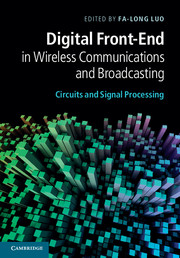Book contents
- Frontmatter
- Contents
- Contributors
- Preface
- Part I Introduction to digital front-end
- 1 Introduction to wireless communications and digital broadcasting
- 2 Basic principles and protocols of digital wireless communications
- 3 Digital front-end and system overview in wireless communication
- 4 System overview and front-end technologies in digital broadcasting
- 5 Digital front-end for multiple standards and multimode compatibility
- Part II DPD and CFR
- Part III DUC, DDC, ADC, DAC, and NCO
- Part IV Digital calibration, imbalance compensation, and error corrections
- Part V Circuits and system integration in digital front-end
- Index
- References
5 - Digital front-end for multiple standards and multimode compatibility
from Part I - Introduction to digital front-end
Published online by Cambridge University Press: 07 October 2011
- Frontmatter
- Contents
- Contributors
- Preface
- Part I Introduction to digital front-end
- 1 Introduction to wireless communications and digital broadcasting
- 2 Basic principles and protocols of digital wireless communications
- 3 Digital front-end and system overview in wireless communication
- 4 System overview and front-end technologies in digital broadcasting
- 5 Digital front-end for multiple standards and multimode compatibility
- Part II DPD and CFR
- Part III DUC, DDC, ADC, DAC, and NCO
- Part IV Digital calibration, imbalance compensation, and error corrections
- Part V Circuits and system integration in digital front-end
- Index
- References
Summary
Introduction
Usually the development of a new standard for wireless communications does not leave the previous ones as obsolete, so it is necessary to share different complex technologies in both the user equipment (UE) and the base-station (base transceiver station, BTS). This implies a strong need for systems integration, especially in handset devices. Besides, the market tendency is to embed in the same UE a number of communications, location, and entertainment applications that some years ago were split among cell phones, PDAs, laptops and dedicated devices, allowing access to both cellular communications networks and WLANs (i.e, different versions of the IEEE 802.11 standard, commercialized as WiFi). Additionally, some WPAN (Wireless Personal Area Networks) applications, such as Bluetooth or Zigbee are also included in some UE, as well as mobile broadcast tuners/decoders (DVB-H, DMB-T, ISDB-T, MediaFLO) and GPS receivers for allowing users to utilize their personal devices as navigators. Also, GPS signals are used in some CDMA base-stations for clock synchronization and in broadcasting transmitters for synchronizing single frequency networks (SFN).
As a consequence, the equipment has to deal with heterogeneous wireless access networks, different in terms of coverage, access technologies, bandwidth, power, data rate, and latency. Besides, developments for new base-stations should support portions of evolving standards, at least the anticipation to modify hardware components and to reconfigure (or upgrade) the software. A multimodal device is a device capable of coping with a number of different standards and applications, supporting different modes operating at different access techniques, data rates, powers, sensitivities, modulations, and codes.
Information
- Type
- Chapter
- Information
- Digital Front-End in Wireless Communications and BroadcastingCircuits and Signal Processing, pp. 120 - 140Publisher: Cambridge University PressPrint publication year: 2011
